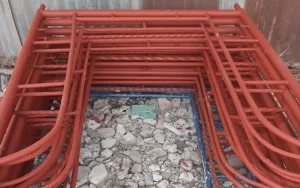Why H-Frame Scaffolding is Superior to Wood
When it comes to construction projects, safety is paramount. Scaffolding plays a vital role in providing safe access to elevated workspaces, but choosing the right type of scaffolding and ensuring proper safety measures are crucial.
At Tamarisk Scaffolding, we prioritize safety and recommend H-frame scaffolding for its superior strength, stability, and reliability compared to outdated options like wooden scaffolding. Here’s a breakdown of essential safety measures for scaffolding use and why H-frames are the smarter choice.
Also read: The Right Scaffolding for your Construction Project
Essential Safety Measures While Using Scaffolding
- Proper Installation
- Scaffolding must be set up on stable, level ground. Using base plates and screw jacks helps to ensure the structure remains steady throughout the project.
- Only trained professionals should assemble scaffolding to prevent misalignment or loose connections. Tamarisk Scaffolding offers expert setup services to ensure maximum safety.
- Regular Inspections
- Scaffolding should be inspected before use and periodically during the project. Look for signs of wear, corrosion, or damage that could compromise the structure.
- A great example is a project we supported at a local high-rise, where routine inspections helped identify a minor issue early, preventing a potential accident.
- Weight Limits
- Overloading scaffolding can cause it to collapse. Always adhere to the manufacturer’s weight guidelines and avoid piling on too many materials or workers.
- For example, Tamarisk Scaffolding’s H-frame scaffolding is designed to support heavier loads than traditional wooden scaffolding, making it the ideal choice for larger projects.
- Use of Guardrails and Toe Boards
- To prevent falls, guardrails should be installed on all open sides of the scaffolding. Toe boards also help secure materials and tools, reducing the risk of items falling and causing injury below.
- Safe Access
- Ensure that scaffolding has proper access points, such as ladders or stair towers. Jumping or climbing onto scaffolding is dangerous and should be strictly avoided.
Why H-Frame Scaffolding is Superior
- Strength and Stability
- H-frame scaffolding is constructed from high-quality steel or aluminum, offering unmatched durability and strength. It can support greater loads and remains stable even under challenging conditions.
- Compared to wooden scaffolding, which can weaken over time due to moisture, rot, or weather exposure, H-frames are built to withstand heavy use over extended periods.
- Quick and Easy Assembly
- H-frame scaffolding is designed for efficient assembly, saving time on site. The frames are easily stacked and secured, providing a robust structure in a short amount of time.
- For example, a project we completed in Nairobi using H-frames saw the scaffolding erected in half the time it would have taken with wood, reducing delays and labor costs.
- Longevity and Cost-Effectiveness
- Unlike wood, which can warp, crack, and degrade over time, H-frame scaffolding is built to last. This durability makes it a cost-effective option for long-term use.
- At Tamarisk Scaffolding, we’ve seen many clients opt for H-frames over wood to avoid frequent replacements and repairs, which ultimately saves them money in the long run.
Why Wooden Scaffolding is a Bad Idea
- Lack of Durability
- Wooden scaffolding can rot, warp, and deteriorate over time, especially when exposed to the elements. This compromises the safety and stability of the structure.
- Imagine a painter working on a multi-story building, only for the wooden scaffolding to give way due to rotting or splitting. This type of accident is easily avoided with steel H-frames.
- Inconsistent Strength
- Wood is a natural material, meaning no two pieces are exactly alike. Variations in strength and quality can lead to weak points in the scaffolding.
- Tamarisk Scaffolding’s H-frames are manufactured to exacting standards, ensuring consistency and reliability every time, something wood simply cannot offer.
- Safety Risks
- Wooden scaffolding, especially when improperly maintained, presents significant safety risks. Its susceptibility to weather damage can make it unreliable and potentially dangerous on-site.
- In contrast, H-frame scaffolding is resistant to the elements and designed for heavy-duty use, offering a safer alternative for construction workers and contractors alike.
Conclusion: Why Choose Tamarisk Scaffolding?
At Tamarisk Scaffolding, we are committed to providing safe, durable, and cost-effective scaffolding solutions. Our H-frame scaffolding not only meets but exceeds industry safety standards, offering superior stability, strength, and longevity compared to wooden alternatives. We take pride in delivering scaffolding that enhances your project’s safety, efficiency, and success.
Whether you’re working on a residential, commercial, or industrial project, trust Tamarisk Scaffolding to provide the scaffolding solutions you need, backed by expert installation, regular inspections, and unmatched customer support.




